Hurricane Ida: Direct Agricultural Impacts and Larger Implications of Flooding
TOPICS
Weather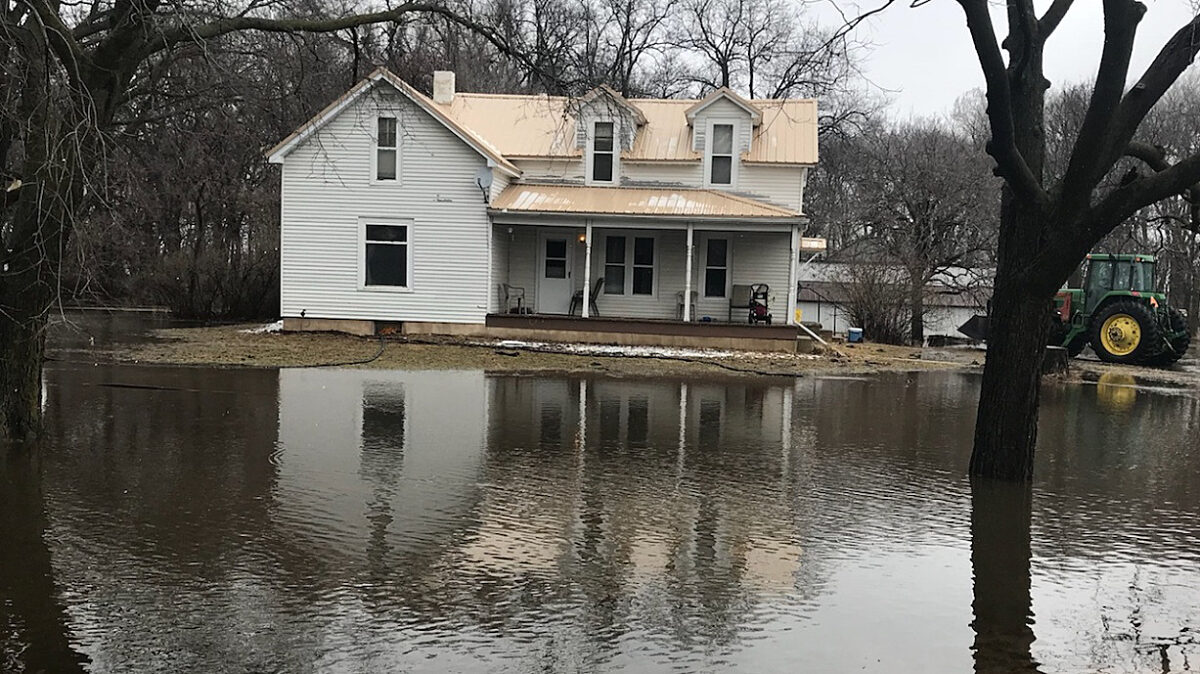
photo credit: Nebraska Farm Bureau, Used with Permission
Daniel Munch
Economist
Hurricane Ida marked the fourth hurricane of the 2021 Atlantic season. Tied in Louisiana landfall intensity with the Last Island Hurricane of 1856 and 2020's Hurricane Laura , Ida touched down on Aug. 26 at 1 p.m. near Port Fourchon as a category 4 hurricane with sustained winds over 150 mph. The storm continued its trajectory on a northeast path toward New England, leaving behind a trail of flooding and severe wind damage. Ida not only threatened crop yields due to direct physical destruction and grain shipments due to port closures, the storm caused widespread infrastructure damage and power outages. Food crops exposed to but not destroyed by flood waters may face mandatory disposal or diversion per the Food and Drug Administration’s (FDA) flood-affected food crop guidance - reducing farm-level production and corresponding income opportunities.
Hurricane Ida made landfall in the Mississippi Alluvial Plain region of Louisiana, which includes the nutrient-rich southeastern low swamplands, coastal marshlands and beaches that makeup the “boot” and Mississippi River basin segment of the state. Responsible for 47.8% of the nation’s sugarcane production by value, this region of Louisiana generates over $540 million in direct sugarcane receipts, representing over 18% of the state’s total agricultural production by value. Figure 1 illustrates the value of sugarcane production by Louisiana county and provides a National Weather Service map showcasing Hurricane Ida wind behavior. Hurricane force winds, as categorized by the agency’s National Hurricane Center, aligned almost perfectly with the state’s sugarcane acreage. Direct damage from high winds and other related conditions threatened the near-500,000 acres of sugarcane crop vital to Louisiana’s economy. Fortunately, wind-flattened sugarcane can still be harvested, albeit through a more time- and energy-intensive process; a surprising 58% of the sugarcane crop was rated as “good” in USDA’s Sept. 7 Crop Progress and Conditions report.
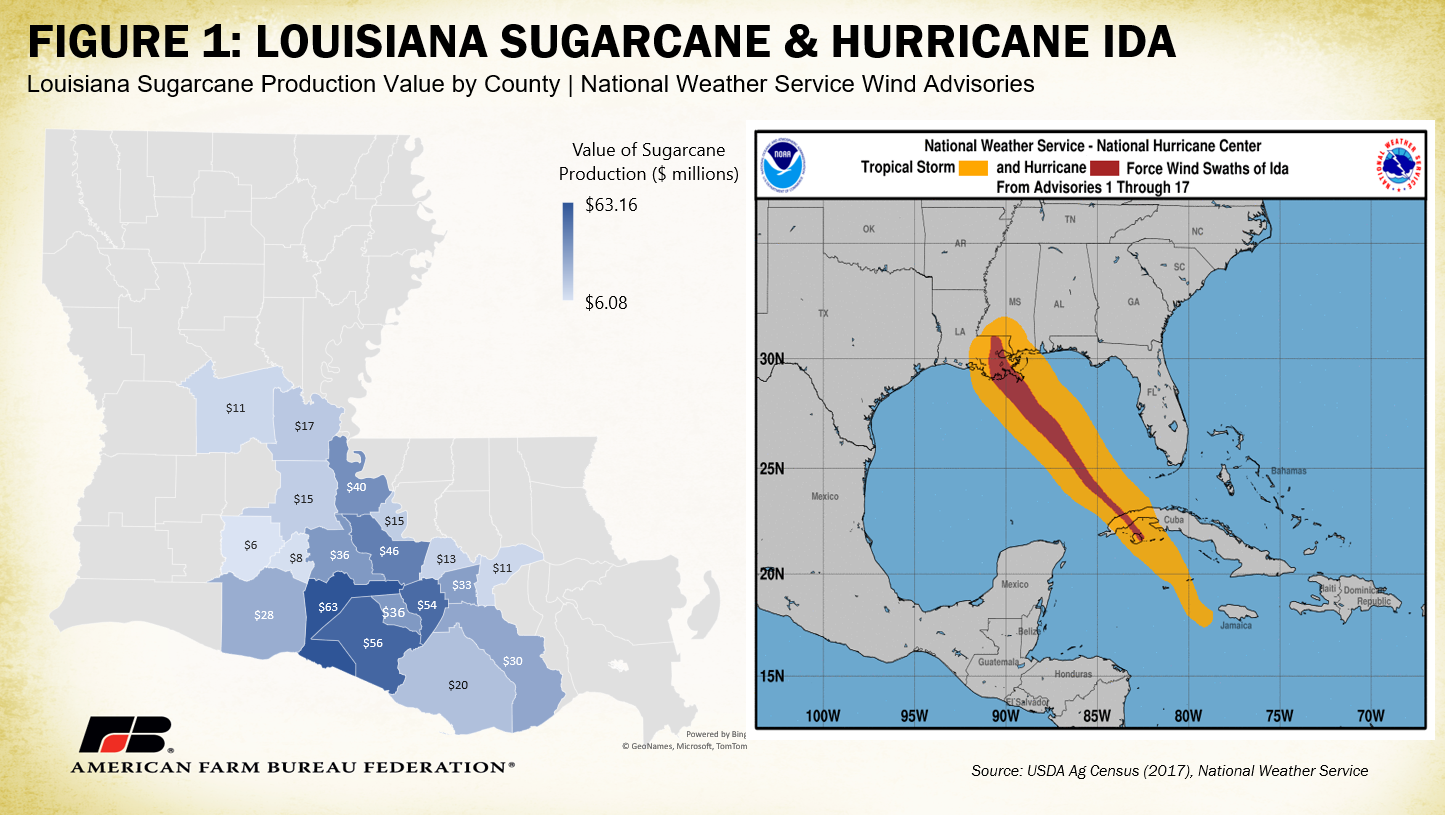
In preparation for Hurricane Ida, on Aug. 28 the U.S. Coast Guard ceased Mississippi River freight movements between river mile 303 and its mouth on the Gulf of Mexico. Responsible for over 60% of U.S. grain exports, the Mississippi River supports the nation’s primary inland waterway system and acts as a backbone for the economies of many heartland states. Unexpected delays and port closures may not only directly limit current shipments of agricultural goods, they may cause foreign partners to view U.S. product as less reliable, prompting them to opt for competing sources such as Brazil or Argentina. Figure 2 displays the weekly change in Gulf Coast (Texas and Louisiana) port traffic for the fourth week of August (35th week of the year) and first week of September (36th week of the year) for 2018, 2019, 2020 and 2021. Between 2020 and 2021, the number of grain vessels at port dropped 67%, the number of grain vessels loaded in the past seven days dropped 86% and the number of grain vessels due for the next 10 days dropped 78% for the first week in September. Similarly, between the 35th and 36th week of the year, grain vessels at port and grain vessels loaded in the past seven days dropped 76% and grain vessels due in the next 10 days dropped 56%.
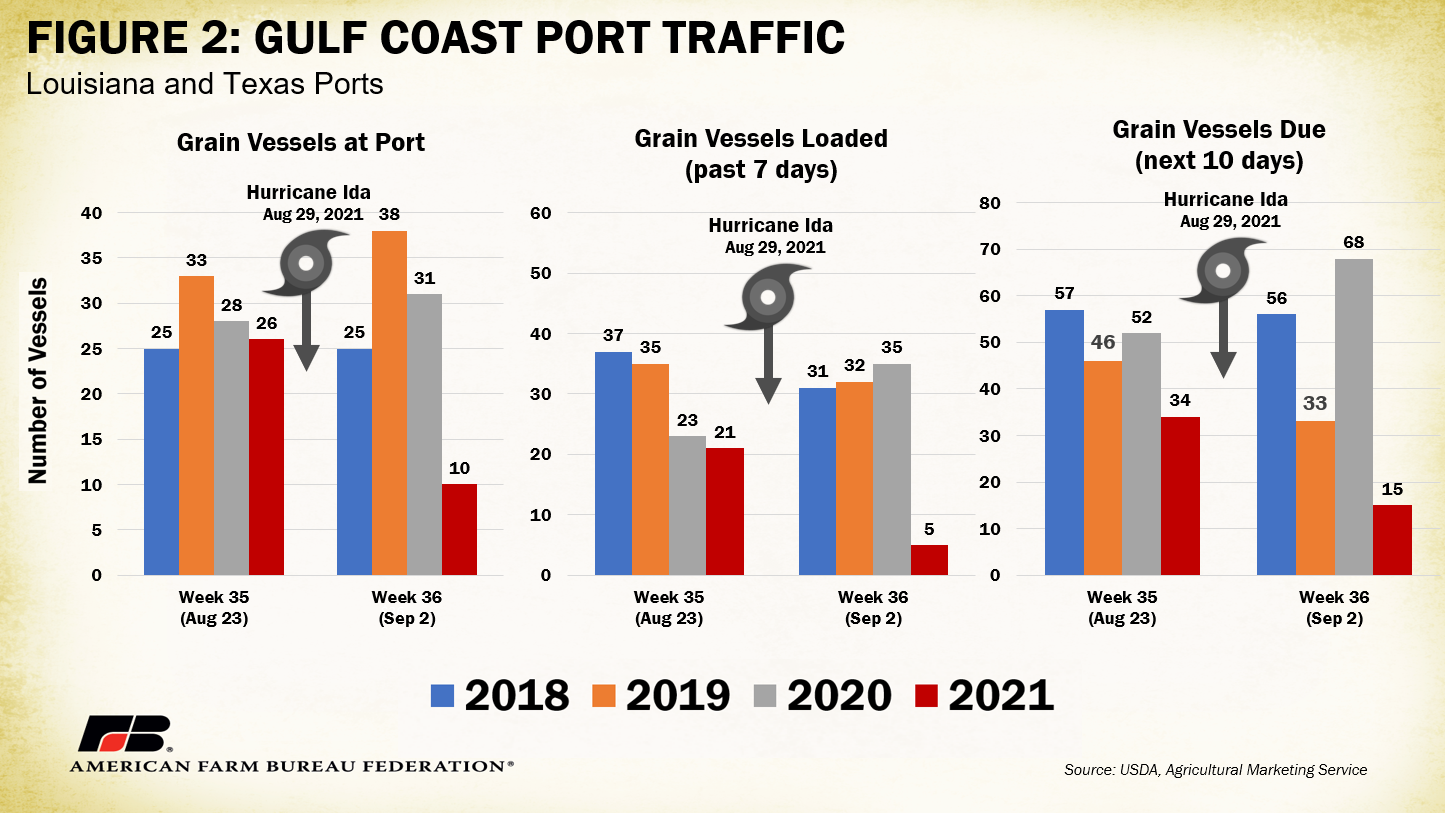
Though the lower Mississippi has re-opened to barge and vessel traffic, obstacles remain for grain shipments. Damaged grain elevators and barge terminals, waterway obstructions and lingering power outages pose longer-term threats to waterborne movements. USDA expects these threats to be limited, as noted in their Sept. 10 World Agricultural Supply and Demand Estimates report: “This report includes updated production forecasts issued by the National Agricultural Statistics Service which generally reflect crop conditions as of the first day of the month. The supply and demand impacts of transportation and port disruptions caused by Hurricane Ida are presumed to be temporary based on available information.” On the production side, NASS acknowledges crop damage assessments are still underway and are not reflected in their September estimates.
Flooding from Hurricane Ida and its subsequent tropical depression classification presents further impacts to the agricultural sector. Figure 3 illustrates the National Oceanic and Atmospheric Administration’s original three-day expectations for flash flooding risk.
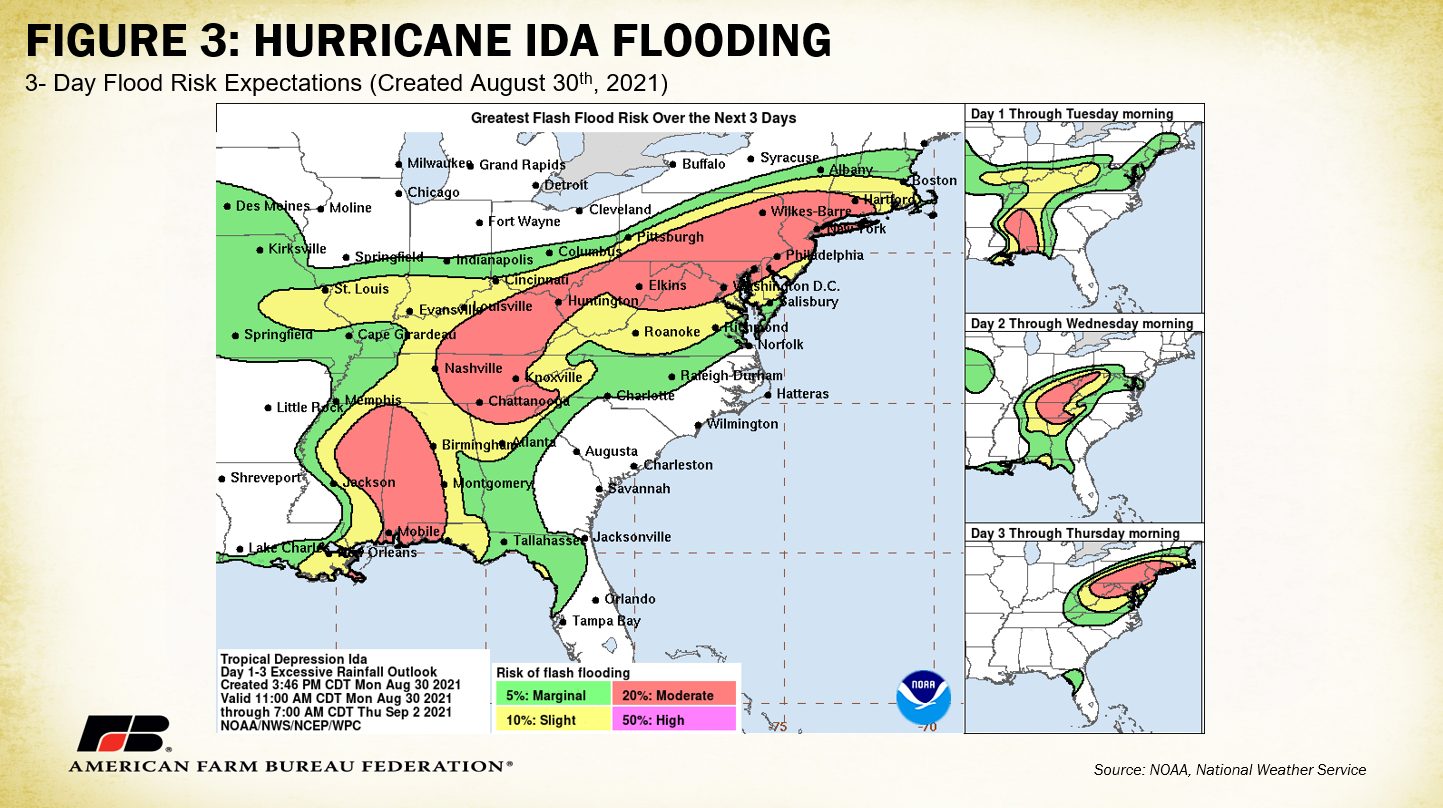
As has been well-televised, many of these flash flood warnings held true, with widespread damage across the Northeast and New England. Additionally, Ida’s damages came only weeks after devastating flooding across central Tennessee, where Humphrey County residents experienced a state-record 17.06 inches of rain within 24 hours. Farmers and ranchers in the region reported lost and killed livestock and submerged field crops. Both events were declared major disasters by President Biden.
The region directly impacted by heavy rains and flooding spans over 15 states responsible for 14% of agriculture commodity production by value or approximately $52 billion in direct agricultural receipts. Beyond 48% of the nation’s sugarcane, Hurricane Ida’s path threatened 85% of the nation’s catfish, 47% of the nation’s tobacco, and 17% of the nation’s dairy production by value. Many specialty crops, including 66% of mushroom production, 29% of pumpkin production, 25% of maple product production, 24% of floriculture, and over 15% of squash, asparagus, snap bean, and apple production by value were also at risk.
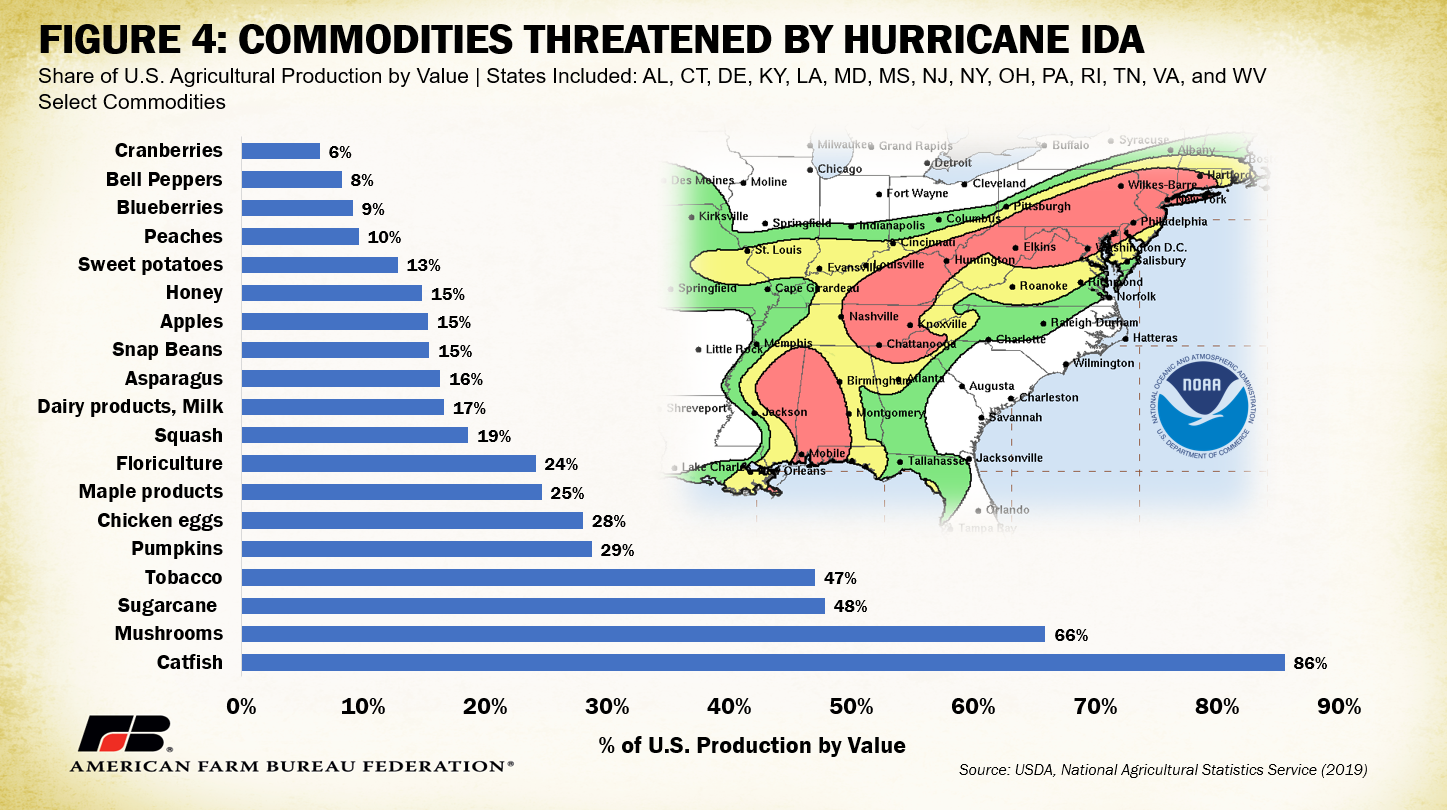
Historically, insured planted acreage for major crops like corn, wheat and soybeans have far outpaced that of their specialty crop counterparts. In most states, over 90% of corn, wheat and soybeans are insured against unexpected losses, while only 76% of fruits and nuts and a dismal 34% of vegetables share this status. Drilling down further, 67% of all insured fruits and nuts and 79% of all insured vegetables are covered by catastrophic risk protection only, which is the minimum level of coverage offered by the Federal Crop Insurance Corporation and generally has higher associated deductibles. Specialty crop losses related to high-intensity weather events, like flooding, are therefore more likely to go uncovered or be covered at a greater cost to producers.
These recent major precipitation events also renew attention on FDA’s guidance on flood-affected food crops. The guidance is intended to protect consumers from contamination that may result from flood water exposed to sewage, heavy metals, pathogenic microorganisms and other contaminants. Under section 402(a) of the Federal Food, Drug, and Cosmetic Act, if an edible portion of a crop is exposed to flood waters it is considered adulterated with “no practical method of reconditioning the edible portion of a crop that will provide a reasonable assurance of human food safety,” meaning exposed food crops cannot be sold for human consumption. The section further defines “all food crops” as:
- Surface crops such as leafy greens, tomatoes, string beans, berries and corn;
- Underground crops, such as peanuts, potatoes, carrots and garlic;
- Crops with a hard outer skin or shell, such as watermelon and winter squash;
- Grains, nuts, corn and similar products stored in bulk;
- Others.
FDA suggests growers whose crops may have been exposed to contaminated flood waters should work with their local FDA office and state regulators to determine if a specific crop can be considered adulterated. Flood waters that do not recede have the potential to impact multiple plantings; FDA recommends allowing soils to sufficiently dry and be reworked prior to replanting. University and state Extension specialists have suggested a minimum 30-60 day waiting period for an inundated field to be safely replanted. Additional guidance related to flood-affected food crops can be accessed here.
Crops destined for livestock feed are not included in this guidance and FDA has historically allowed contaminated food-crops to be diverted for animal feed use. Guidance related to the diversion of adulterated food to acceptable animal feed use can be located here.
Conclusion
In 2020, severe rainstorms and hurricanes resulted in over $700 million in crop losses. Already in 2021, farmers and ranchers have been hit with severe winter storms, extreme drought and record flooding, risking further losses across the agriculture sector. Hurricane Ida marked the latest in the widening list of major weather events for 2021 and surely tested the resiliency of Gulf Coast crops and ports. Furthermore, widespread flooding across the Eastern U.S. revived the need for FDA’s guidance on flood-affected crops, which can put product bound for human consumption on the wrong chopping block.
